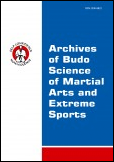2015, Volume 11, Issue 1
Movement structure in fencing lunge in elite fencers and beginners
Ĺ tefan BalkĂł1, Iva BalkĂł1, VladimĂr SĂĽss2
1Faculty of Education, Jan Evagelista PurkynÄ› University in ĂšstĂ nad Labem, ĂšstĂ nad Labem, Czech Republic
2Faculty of Physical Education and Sport, Charles University in Prague, Prague, Czech Republic
Author for correspondence: Ĺ tefan BalkĂł; Faculty of Education, Jan Evagelista PurkynÄ› University in ĂšstĂ nad Labem, ĂšstĂ nad Labem, Czech Republic; email: Stefan.Balko[at]ujep.cz
Full text
Abstract
Background and Study Aim: The criterion for successful hitting the opponent during the lunge in fencing is the right timing of the attack and suitable timing in muscle coordination. From the elite fencers we expected application of movement patterns, which had been reinforced during the training. The aim of this study is knowledge about kinematic characteristic of fencing lunge in different performance-related groups of fencers (elite and beginers).
Material and Methods: The first group (n = 7) consists of elite fencers of the Czech Republic, who are active in fencing an average of 12 years (±3.4). In the second group (n = 7), there are fencers who are active in fencing up to two years. Athletes performed lunge on a visual stimulus of LEDs, which is part of the Fitrosword device. Video recording (high-speed camera) and Dartfish Team Pro 6 Data software were used to evaluation of movement structure of the lunge.
Results: The elite fencers had lower value of reaction time. Significant differences between beginners and elite fencers was found in time required for front elbow extension and in activation of front upper limb before front lower limb. In elite fencers were armed arms activated before the lower front leg significantly earlier than in beginners who initiated their lunge preferentially with activity of the lower limb on the side closer to the target.
Conclusions: The results of our study can be used in the training proces for improving the efficiency on the implementation of the lunge with regard to the optimal structure of this motion act applied by an elite group of fencers.
Key words: combat sports, kinematic analysis, movement time, reaction time, visual stimulus





